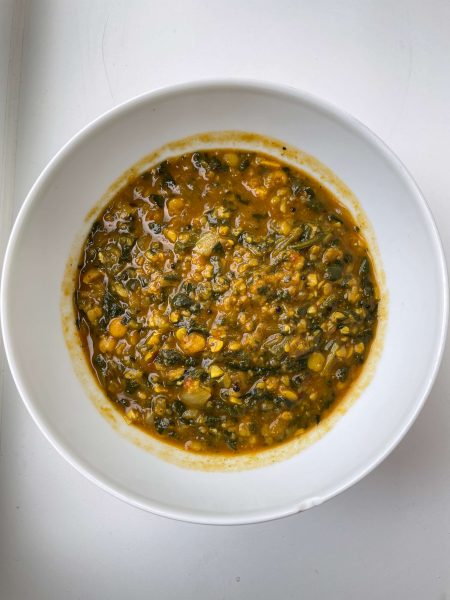I can’t begin to tell you how many combinations of vegetables and pulses (dals) are contained within the Indian food library. It’s mind- boggling how many dishes my mother churns out that have slight variations both in terms of main ingredients and spices. And those little changes make all the difference to render the taste of each meal distinctive and unique. All types of dals however, have huge nutritional benefits and are a staple Indian food particularly if one is vegetarian, as they are high in protein. I absolutely love the taste of all meals where dal is the main ingredient. In the West, we think of dal as a type of soup, which of course it does resemble, but Indian cuisine also uses dal in slightly drier vegetable and meat dishes.

There are so many dals in Indian cuisine
This is a vegetable dish, not a ‘dal’ as such, and it can be eaten alone with chapatis or rice, but it can also be cooked to form part of a bigger meal, such as a dinner party meal, with other dishes such as meat or fish curries, and also with other vegetables if you are cooking a vegetarian meal. I love the rich consistency and creamy taste of this dish which my mother adapted from a recipe she got from my cousin in India. It’s made creamy by part- blending it at the end. As with all Indian food, you need to think and plan ahead if you want to make dal. Dal and rice are never cooked in Indian households without soaking them first. Some heavier dals are best soaked overnight, but certainly with all of them, at least an hour is essential. Soaking removes lectin, a protein found in many legumes and grains, which we cannot digest. Many people say they feel a bit bloated or uncomfortable after eating pulses, and decide they have an intolerance to them…this is probably because they haven’t been soaked. Soaking will also speed up the cooking process once you are ready to make a meal. Cooking should be enjoyed and never rushed, and this applies especially to Indian food that is prepared in different stages, and uses lots of ingredients, each of which is essential to the overall taste. Patience is key, and cutting corners simply won’t work, but the end result is always worth it.
Ingredients to serve 3-4 people as a side dish or 2 people as a small main meal:
3 tbsp each of skinless mung dal, toor dal (pigeon peas) and chana dal (split Bengal gram) soaked in plenty of hot water for an hour
A bunch of fresh spinach leaves (not baby spinach) washed well and finely chopped
A small onion, finely chopped
2 tsp finely grated ginger
2 fat garlic cloves, finely chopped
A small green chilli, chopped small
Half a tin of chopped tomatoes, slightly blended
Half tsp black mustard seeds
Half tsp cumin seeds
Half tsp caraway seeds
Half tsp garam masala
1.5 tsp amchoor (dried mango) powder
Half tsp turmeric powder
A heaped tsp each of ground cumin and coriander
Half level tsp mild chilli powder (Kashmiri)
A tbsp rapeseed oil
A tbsp ghee
Salt to taste
Method:
Heat the oil and ghee in a deep frying pan with a lid. Add the mustard seeds and cumin seeds and let them start of fizzle. Now add the caraway seeds and stir for a few seconds before throwing in the onions. After a minute, add the garlic, ginger and green chilli. Stir well for 2 minutes before adding the garam masala and amchoor powders. Next add the turmeric, ground cumin and coriander, as well as the chilli powder. Stir everything well for a minute or two, before adding the tomatoes. Now make sure the heat is on medium , and let the gravy cook for 10 minutes or so, until the tomatoes have thickened and become thoroughly incorporated. You can add a little hot water if it is looking too dry.
Now drain the dals and add them to the pan along with around half a tsp of salt and enough hot water to just cover the mixture. Cook with a lid on for 25 minutes, checking and stirring from time to time, before adding the spinach. Mix it in well and cook for a further 15 minutes or so.
Once cooked, use a hand blender or even a potato masher to part-mash around a third of the mixture. Check and adjust seasoning.
Serve hot with a chapati or two, and perhaps some basmati rice.
